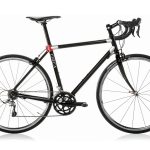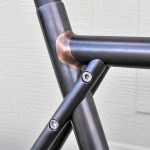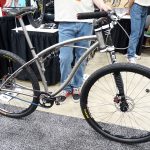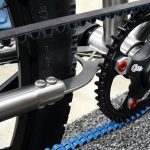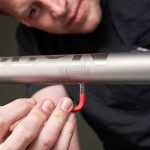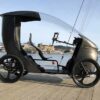Alternatives to Welded Bike Frames: Adhesive, Lugs, Threaded and Hybrid Joints
7.10.2021
8235
The popularity of welded bicycle framing is not decisive. Many titanium, steel, or aluminum frame manufacturers use alternate connections, which in many cases not only enhance the bicycle’s consumer qualities, but they also make it simpler and cheaper to produce.
In spite of numerous innovations, basic frame design of the classical bicycle has changed little since the chain-driven version appeared around 1885 [1]. The first vehicle, however, was invented by the German Baron Karl von Drais in 1817 and was based on a wooden beam frame with two wheels. Subsequently, bicycle frames were also constructed of wood or cast iron, and their components were interconnected by lugs of various designs. The bamboo bicycle, which appeared around 1894 [2], like its contemporary counterparts, has also had a frame without welding. As welding technology emerged, the majority of bicycle frames were made of steel tubing, and subsequently aluminum tubing.
But the era of frame components joined without any welding did not end there. With the aim of decreasing frame weight, the manufacturers have continued to look for lightweight and stronger materials, which could not always be joined by welding. Among the most famous is the example of the French manufacturer Pierre Caminade. In the mid 1930s, he devised a lightweight frame design based of duralumin octagonal tubes, which were connected by special lugs [3].
The Finnish concept idea2cycles also is an interesting idea that aims to design new models of low-cost bicycles and bring them to market quickly. The development is a simple but brilliant design that integrates lightweight alloy tubes that are joined together by means of bushings and adhesives as part of the bicycle frame structure. 3D technology and a magnesium material are used for the precision molding of the bushings to reduce weight [4].
Circa Cycles of America uses a patented proprietary manufacturing procedure that produces a custom bike weighing 9.75 kilograms in just 10 hours or less, compared to the typical 50-100 hours of manual labor that other companies need to produce such a bike [5]. “In a way, it’s like a combination of Ikea, Lego and Swatch,” says founder Rich Fox. The frame components, these unique bicycles, are assembled with CNC-machined lugs, bolts and the special glue used to build race cars and planes. The frame elements are then anodized in different laser engraved with an “ornament” of the buyer’s choice, rather than using a manual painting process.
The idea for the glued frames with the lugs was inspiration from Italian bicycle brand Alan, which used a similar process in the 1980s. Rich Fox bought Alan in 1984 and still owns it. “It was my very first real race bike,” he says. “This bike is 34 years old, and it’s still good. The anodization still feels like new” [6]. Today’s epoxy and bonding processes are still more reliable, like the 6061 aluminum alloys tubing used in the frame.
Usually, bike models are prefabricated with different frames sizes in the hope that all of them will eventually be sold. Circa contemplates a system in which prospective customers would walk into the showroom, select a bike model, package it, and place the order, which would be manufactured in the size they chose. Of courses, custom bikes already exist, but they tend to be hand-made and thus very expensive.
The MABEL – or Modular and Bonded Endless Lug – technology from Circa Cycles solves this issue by using lugs (the bits that join the tubes together), which are made from separate aluminum parts milled on CNC machines. When a frame is ordered in a given size, a different combination of components is selected for each model to produce the desired design [7].
Dave Lindberg is an ingenious bicycle frames designer who solders steel construction in his Portland, Oregon garage and with his new road bike, and he continues to experiment with unique styling concepts and using unconventional assemblies and parts [8]. The rear stays of his frame have special inserts by which they are bolted around a seat tube. The construction forms the frame’s rear triangle and at the same time clamp the seat tube, on to which the seat is positioned. The full assembly together with the Pinion C1.6 transmission weighs 11.5kg, with 1.8kg going to the gearbox.
Not less interesting construction of a frame was designed in the company Black Sheep Cycles [9]. They have presented a titanium, pivotless full suspension bike with the belt drive, and without any straining device at the connection point of the rear stays. This construction has a short stroke and uses a flattened flexible section directly behind the bottom bracket for flexing. The lower stays are attached to this titanium sheet with bolts. The bolt openings on the plate are longitudinally slotted so that you can adjust the belt tension before you tighten them. Another advantage of this construction is that the back triangle of the framework of such a cycle can be screwed off and detached, which facilitates, for instance, the shipping of the bike on an airplane or on a train.
The filigree forms of the milled aluminum alloy 7075 frame of Frace Bike F160 cause the genuine admiration of the connoisseurs [10]. The bike weighs about 17 kg, has 160 mm of travel and 27.5-inch wheels, and its frame is made up of eight parts. Frace F16 does without any glue joints: the headtube, the top tube, the downtube and seat tube are completely milled from a single block. All in all, the multi-hole framework consists of a total of eight various components, which include the lever and the rear end, which are attached to each other with titanium bolts.
One cannot fail to note that the Bicycle Torque Coupling, or as they are also called S&S Coupler [11], is quite a popular lock for steel frame or titanium frame among traveling cyclists. The set comprises two precision machined fittings and a screw locking nut and is designed to split a titanium or steel frame into two pieces for compact shipping in a standard airline suitcase. Multiple tests have demonstrated that whether such connectors are installed on the bike during manufacturing or added as an upgrade later, S&S connectors have no negative effect on the frame structural integrity of the bike.
This isn’t the only version of this connection of frame parts. The new system from No 22 Bicycles enables hydraulic braking cables and pipes to be run through the inside of the locks and consequently the frame tubes, enabling the rear braking system to be decoupled from to the front of the bike [12]. At the same time, only a single 6 mm hex screw is needed for each of the two framing couplings. By borrowing its construction from quick-connect brake connections from the world of motorcycles, the Brake Break system allows you to connect and disconnect the bike’s hydraulically operated hydraulic brake hoses instantly and with no tools required. At the same time, there is no need to bleeding the brakes even after repeated use.
This brief review concentrated on frames made of tubes made of titanium, steel or aluminum and did not consider bamboo, wood or carbon fiber construction, where no alternatives to lugs, glue or hybrid joints are available. Nevertheless, it can be deduced beyond any shadow of a doubt that adhesive, lock, thread and hybrid bike frame joints successfully coexist with welding, giving the manufacturers the opportunity to realize their boldest developments, and the consumers – to select the most suitable bike model for themselves.
It is important to note, at the same time, that in the automobile as in the bicycle industry, the manufacturers continue to look for the most lightweight and durable materials, innovations among which are appearing every year. New materials are often dissimilar and challenging to join with welding techniques, which will no doubt lead to an increase in alternatives to welding.
Look at:
[1] Bicycle – https://en.wikipedia.org/wiki/Bicycle
[2] The History of Bicycles – https://historycooperative.org/the-history-of-bicycles/
[3] Cycling duralumin frames? Been there? Got any? Will be? – https://avialbikes.com/news/cycling-duralumin-frames-been-there-got-any-will-be/
[4] Design Challenge (DAMC) 2016 – http://ideas2cycles.com/competitions/design-challenge-damc-2016/
[5] This Company Wants to Bring Back American Bike Manufacturing
– https://nationswell.com/circa-cycles-builds-affordable-custom-bicycles/
[6] CIRCA Cycles: Bonded and Anodized in PDX – https://blog.gatescarbondrive.com/2016/11/14/circa-cycles-bonded-and-anodized-in-pdx/
[7] Circa Cycles takes a modular approach to keeping costs down – https://newatlas.com/circa-cycles-mabel-lugged-frames/34678/
[8] BREAKING AWAY: APT CYCLES PINION BELTER TRAVEL BIKE – https://www.thespoken.cc/apt-cycles-pinion-belter-travel-bike
[9] Black Sheep Cycles’ Belt Drive Full Suspension 29er – https://bikerumor.com/2011/03/11/nahbs-2011-black-sheep-cycles-belt-drive-full-suspension-29er-monster-cross-and-36-mountain-bike/
[10] Neues Frace Bike F160: Einfach mal aus dem Vollen fräsen! – https://www.mtb-news.de/news/frace-bike-f160-infos/
[11] S&S Coupling – https://www.ticycles.com/sands-coupling
[12] No 22 Bicycles new frame coupler system – https://www.cyclefit.co.uk/custom-bikes/no-22-bicycles-new-frame-coupler-system
